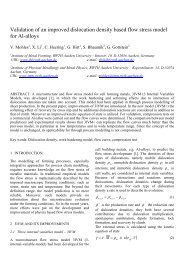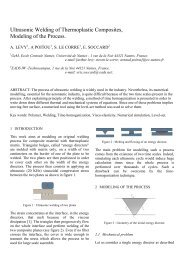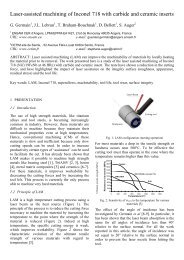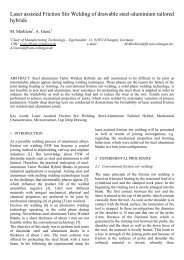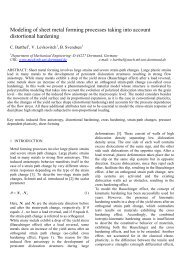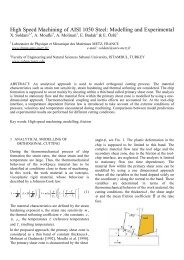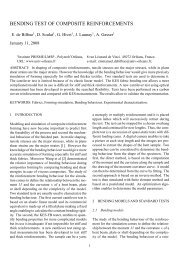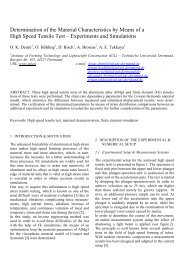Here - the ESAFORM 2008 Conference - INSA de Lyon
Here - the ESAFORM 2008 Conference - INSA de Lyon
Here - the ESAFORM 2008 Conference - INSA de Lyon
You also want an ePaper? Increase the reach of your titles
YUMPU automatically turns print PDFs into web optimized ePapers that Google loves.
eduction rate (normal and tangential forces aremeasured as output parameters). A methodology was<strong>de</strong>veloped by Deltombe & al. [1]: thanks toindustrial and experimental FEM mo<strong>de</strong>ls, <strong>the</strong> testparameters enabling <strong>the</strong> experimental reproductionof industrial contact stresses and industrial plasticstrain are computed.3.2.c Thermal conditionsA convective heating system has been recently<strong>de</strong>signed to control interface temperature. Thissystem is associated with a convective coolingsystem to protect sensors and thus to avoid drift ofmeasurements or even <strong>the</strong>ir <strong>de</strong>gradation.3.2.d Lubrication conditionsA new methodology of lubrication application hasbeen <strong>de</strong>signed to solution this problem andreproduce industrial lubrication regime.4. SIMULATION OF LUBRICATION4.1 Lubrication by oil-in-water emulsion in coldrolling processThe Wilson <strong>the</strong>ory, called dynamic concentration<strong>the</strong>ory [9] corresponds to <strong>the</strong> process studied herein.Because of oil high viscosity, this <strong>the</strong>ory supposesthat quasi no water or a tiny amount of water enters<strong>the</strong> roll bite [10]: water is mainly used as coolantfluid.The thickness of oil penetrating <strong>the</strong> contact isdirectly influenced by rolling speeds, oil viscosityand concentration, materials, contact pressure androll bite geometry [8]. In section 2, lubrication was<strong>de</strong>fined as almost boundary. Generally <strong>the</strong> minimallimit of a mixed regime thickness is consi<strong>de</strong>re<strong>de</strong>qual to:h lim = 0,35.R a [6] (1)where R a = mean strip roughness.4.2 Methodology: computation of required oilquantity to applyNo water is consi<strong>de</strong>red entering <strong>the</strong> roll bite: testwill be ma<strong>de</strong> with neat oil. Speeds not beingreproducible, lubricant feeding cannot be simulatedon URT: <strong>the</strong> solution is to apply <strong>the</strong> good amount ofneat oil on URT specimen beforehand. The usedlubricant thickness for this study is <strong>the</strong> most criticalvalue we could meet in cold rolling, i.e. h lim , <strong>de</strong>finedin 4.1. The mass corresponding to this thickness iscomputed according to <strong>the</strong> following procedure.Thanks to a 3D profilometer, <strong>the</strong> first step is tocalculate <strong>the</strong> mean roughness, R a , of strip studiedherein and to <strong>de</strong>duce (1) <strong>the</strong> corresponding thicknessto apply on it. Then, from a 5 mm² specimen surfacepreviously analysed by <strong>the</strong> profilometer, computersoftware enables to calculate which volume of oil isnecessary to fill in <strong>the</strong> valleys in or<strong>de</strong>r to obtain <strong>the</strong>required lubricant thickness computed in first step.Finally, knowing oil <strong>de</strong>nsity <strong>the</strong> mass is <strong>de</strong>duced.As a validation of <strong>the</strong>se recent optimisations,experimental surface aspect shows a scaly surface asfor <strong>the</strong> industrial one after two passes (Fig. 1.b, 1.d).5. TESTS AND RESULTS5.1 Test objectives and conditionsThe aim is to analyse <strong>the</strong> influence of rollingparameters such as <strong>the</strong> pass number, <strong>the</strong> interfacetemperature and <strong>the</strong> forward slip on friction andwear (iron fines creation and surface aspects). All<strong>the</strong> test configurations are indicated for each pass ontable 1. The quantity of lubricant applied onspecimen strip is <strong>the</strong> mass corresponding to <strong>the</strong>thickness h lim (Eq. 1). Each configuration of test hasbeen reproduced twenty five times.Table 1. URT test configurations for each passConfiguration number 1 2 3 4Forward slip 2% 2% 7% 7%Interface temperature 40°C 120°C 40°C 120°C5.2 Results and discussions• Friction:The coefficient values corresponding to eachconfiguration are represented on Fig. 3.a:o Coulomb friction coefficient is higher in passtwo than in pass one whatever <strong>the</strong> testconfiguration. This can be explained by <strong>the</strong>increase of <strong>the</strong> contact ratio with <strong>the</strong> passnumber. As an evi<strong>de</strong>nce, nearly no hole (orlubricant “traps”) remains once pass 2 has beenperformed (Fig 1.b)o Coulomb friction coefficient increases withtemperature. For a quasi-boundary lubrication



